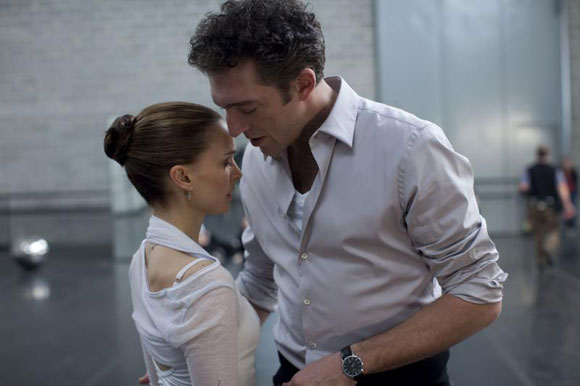Black Swan

L-R: Natalie Portman and Vincent Cassel in BLACK SWAN; Photo by Niko Tavernise

The film opens with the driven Nina Sayers (Natalie Portman) dreaming of performing in the lead role of the Swan Queen in the New York City Ballet’s production of Swan Lake. Diffusely lit in the waltz-like motion of Matthew Libatique’s 16mm cinematography, Rothbart (Sergio Torrado) transforms into a malevolent figure before our eyes in the prologue to the famous ballet. Nina awakens into her daily routine of stretching exercises, then breakfast—one egg, half a grapefruit—with her domineering ex-ballerina mother, Erica (Barbara Hershey). In a few glances and pauses, we can see the tense relationship between mother, also referred to in the credits as “The Queen,” and daughter.
The movie’s plot parallels that of Swan Lake. In Tchaikovsky’s play, Princess Odette is cursed by von Rothbart to be a swan by day, woman by night. Von Rothbart’s daughter, Odile, is disguised as Odette in an attempt to fool the Prince Siegfried into breaking his vows with her.
Enter Lily (Mila Kunis), just off the plane from San Francisco. While she attempts to befriend Nina, they’re both competing for the same role. Lily’s carefree attitude and fluid movement seem to embody the Black Swan better than Nina. Keeping with tradition, ballet director Thomas Leroy (Vincent Cassel in a role perfectly tailored for his charismatic smarm) casts one ballerina to play both Swans. The company’s own dying swan, the aging Beth Mcintyre (Winona Ryder), is being replaced. That’s business.
When we first see Thomas, his reflection in the studio mirrors is distorted. Mr. Cassel reportedly based this twisted, dictatorial character on George Balanchine, founder of the NY City Ballet. The actor notes that there is no hero in the film; each character is damaged in some way. In that regard, they all play their insecurities off one another. Thomas’ confrontational nature becomes the catalyst that unleashes Nina’s particularly warped side.
After some deliberation, Thomas declares that Veronica (Ksenia Solo) has the part. Nina congratulates her only to be met with expletives spat forth with such venom. Nina got the part. The director simply told her otherwise to provoke her to fight for it, wanting to see whether she could embody the darker side of the Swan Queen. As she becomes more immersed in the production and the part, she begins to unravel.
Ms. Portman lacks nuance. Either she tends to wooden performances or goes all-out, not necessarily the mark of a talented actor. However, here writer/director Darren Aronofsky channels those extremes into a part specifically requiring both timidity and abject psychopathy.
Ms. Kunis exhibits a freedom here in ways she hasn’t captured on screen before. I think, and I’m sure I’ll get some odd stares for this, her tenure on the animated sitcom Family Guy has contributed considerably to her ability to tackle the role of, effectively, Nina’s doppelgänger. Her comedic roles with Seth MacFarlane’s pastiche of All in the Family and That 70’s Show, in her often-underrated performance as a superficial but clever teenager, Ms. Kunis has here deftly distanced herself the stereotypes that could easily have plagued her career.
The combination of Clint Mansell’s original, tense score and elements of Tchaikovksy’s signature pieces from his ballet mesh rather well. They also hint at the depth of disconnect Nina has with reality, as the story and characters of the film gradually progress into a ballet within a ballet.
Black Swan is, at its core, the story of a paranoid schizophrenic who suffers from auditory and visual hallucinations. It’s interesting to go back through the film and spot the “breaks” with reality, and the moment in which Nina’s personality fractures. It also fits that Nina’s mother seems herself a manic-depressive, or at least obsessive-compulsive. Her histrionics influence her daughter’s paranoias.
While Mr. Aronofsky at times indulges too much with this fantastical vision, going at times a step farther than he needs to with CG-aided hallucinations, one quickly gets swept up into its theatrics. The transgressions are minor compared to Mr. Aronofsky’s earlier, unhinged works. With his film The Wrestler, he appeared to have gotten his runaway fantasies under enough control so as to keep the storytelling anchored in some meaningful way. Sure, Black Swan is Showgirls meets Fight Club on crazy pills. But how can you go wrong with that combination?
 Black Swan • Dolby® Digital surround sound in select theatres • Aspect Ratio: 2.35:1 • Running Time: 107 minutes • MPAA Rating: R for strong sexual content, disturbing violent images, language and some drug use. • Distributed by Fox Searchlight Pictures
Black Swan • Dolby® Digital surround sound in select theatres • Aspect Ratio: 2.35:1 • Running Time: 107 minutes • MPAA Rating: R for strong sexual content, disturbing violent images, language and some drug use. • Distributed by Fox Searchlight Pictures
Dolby and the double-D symbol are registered trademarks of Dolby Laboratories.